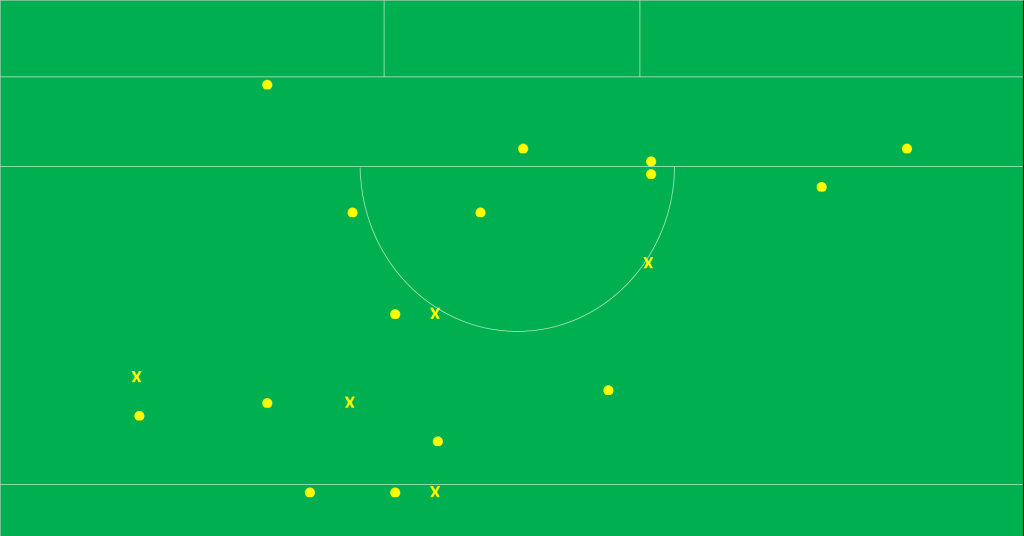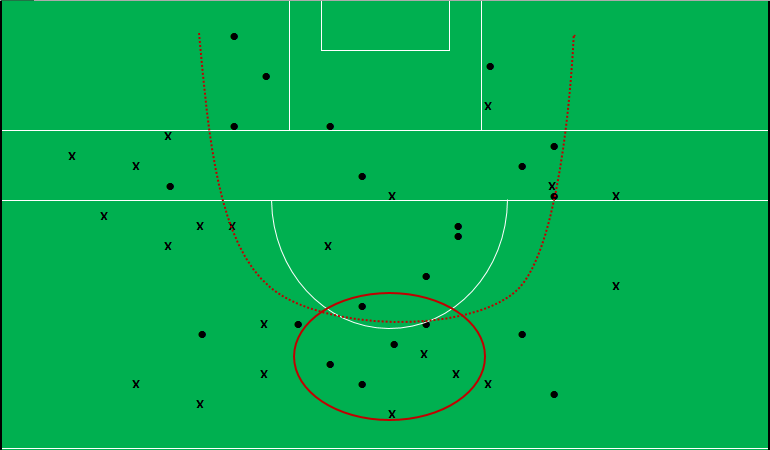Keys to the game
- Can Kilcoo break down that Kilmacud defence? Conversely can Kilmacud stay in their shape for ~65minutes and not fall victim to a late goal?
- If forced out how efficient can Kilcoo be on higher variance shooting?
- Can Kilmacud continue to get a higher percentage of their shots off from the central channel?
- Kickouts; will Kilmacud press and if they do will Kilcoo continue to force them in? What do Kilmacud do? A Kilcoo hammer blow awaits on anything that drops short of the 65.
- And finally, the referee. Kilcoo had 17 shots from frees in their three games. But gave up 20. If this turns into a tight possession driven game – with both teams prodding for an opening – how the players shape the referees view of their tackling could be the decider
When Kilcoo have the ball
Kilcoo are very (very) patient with the ball. Of their 118 possessions in the three games under review (v Glen and Derrygonnelly in the Ulster campaign and St. Finbarrs in the semi-final) they strung ten or more passes together on 46% of them. All other club teams in this year’s review (13 non Kilcoo games – 26 different team performances) combined for 23%.
Their patience is not to be mistaken for passivity. They continuously probe with 25% of all their individual possessions being inside the opposition’s 45 and about a quarter of all possessions involving multiple entries into the 45 … they gain possession, bring it up to the 45 and start to probe right using Shealin Johnston’s speed to cut in to goal, down the middle primarily with Daryl Branagan or on the left with Eugene Branagan or Ceilum Doherty. If it is a quick break from a turnover Ryan Johnston picks up the ball on the 65 and runs at speed at you. They prod and thrust looking for the weak shoulder to attack or the cut in towards goal. If it does not come, they are happy to recycle back out to the 45 and go again. And again.
It must be absolutely draining to defend against. And this is shown up somewhat in two ways. The first is the volume of shots from frees they have attained with 17 across the three games – Kilmacud, in their three games under review, have only had eight.
Secondly, they have manufactured ten attempts at goal but only two of the ten have come before the 40th minute. The constant prodding and poking eventually leads to defences opening up. And that opening up, alloyed to Kilcoo’s willingness to go over and back, leads to the attempts landing at various players’ feet … eight different players have attempted those ten shots at goal. And they have been clinical with those attempts scoring 5-03.
Does the approach help their attack? Given their patience, and probing, their scoring efficiency is aided by where they shoot from rather than by excellent shooting. There is nothing wild. Nothing from more than ~35m out.

But is it predictable? By being so patient, and not shooting from the 45, they let teams set their defensive block deep on top of the D. Kilcoo have not gotten shots off in the pocket straight in front of goal (red above) … instead it is in an arc around the D (blue above). There is no real lean to either side; on the attacking left they are 45% (0 – 09 from 20) whilst on the right they are better (0 – 11 from 18) but that is probably due to more shots being closer to centre.
Deadball efficiency is as expected – probably a touch below average just given the propensity to miss those on the D

The template is simple enough. Control the ball. Control the game. Pull teams back and forth until there is a gap then pull the trigger in closer to goal or force the opposition to foul. As teams tire, they may not be able to close those gaps, or keep up to foul. Go for the jugular.
But that is just one side of the coin. How have the Kilmacud defence performed with these points in mind?
They have allowed six attempts at goal with four of those coming from St. Judes. In their last two games Padraig Pearses did not get an attempt off whilst Naas had two – both taken under severe pressure with the second coming late in the game (58th minute). Kilmacud have been particularly good at protecting that goal of late.
That is also shown up in the combined shot chart for Pearses & Naas … look how clean that area (known as the McGowan/O’Carroll zone) directly in front of goal is.

That is what every defence in the country wants their chart to look like. They do give up those shots around the D but that is high variance stuff – if they keep Kilcoo shooting from out there they will be more than happy.
One further point on the possession is where it emanates from. Kilcoo have gone short on 31 of their 38 kickouts. They want primary possession and are willing to fit the ball in to get it … only six of those 31 short kickouts were received uncontested or under no pressure. 11 were received under pressure, or with a man draped over the receiver, whilst another 14 were received whilst the opposition were pressing. And none were lost.
They have been clinical on the opposition’s kickout. They have faced 48 and won ten … getting their hands on one in five. But of the ten they won they produced nine shots scoring 2-04.
When Kilmacud Crokes have the ball
Kilmacud can be patient on the ball as well. Within the three games under review (v St Judes in the Dublin final, Naas in Leinster & Padraig Pearses in the semi-final) the percentage of possessions with ten or more passes came in at 32%. Not as high a proportion as Kilcoo but still higher than the average.
Their shooting is much the same as Kilcoo’s, but they are more willing to shoot from further out with that pocket at the top of the D being quite productive.

The above chart includes the St. Judes game when Paul Mannion was in the team. Despite being 13 he did not necessarily shoot from the offensive right that game … and his absence against Naas & Pearses hasn’t led to any huge pattern in their shooting. They were very balanced in those two non-Mannion games with seven point attempts from the right and seven from the left

Kilmacud have only (when compared to Kilcoo), attempted eight shots from frees across the three games and ten deadballs in total. Their returns have been a tad below average as Ferris has missed two 45s and a straight on free so it cannot be considered a strength.

But if Kilcoo continue to foul at the rate they have to date (eight against Glen in normal time; similarly nine to St. Finbarrs) then average may be good enough as the volume will aid their returns.
One major point of differential between the teams is the kickouts. Kilcoo went short 82% of the time (31 of 38). Kilmacud only went short on 33% (11 of 34) of theirs.

Part of the reason is that they are not as set to go short as Kilcoo are … they have lost three of those 11 which is a huge amount. And on top of that they have lost six of the 11 that have landed between the 45 and 65.
22 kickouts short of the 65 which should be prime retention ball – yet they’ve lost eight. And to date Ferris has not shown a propensity to be able to outkick any press. He can get them to the land between the 65s but not beyond.
Kilcoo are deadly when they get their hands on the opposition kickouts. Kilmacud have really struggled getting primary possession from their kickouts. How Kilmacud navigate this (or indeed what traps Kilcoo set them) will go a long way to determine the game.





